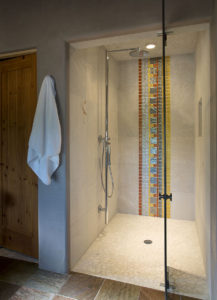Food for the Soul

We begin by pondering sustenance. Apart from air, food, water, shelter and love, we are sustained internally by many factors, individually specific. We are affected and transformed by that which surrounds us: sound, stimuli, beauty, or a sense of comfort. We move through spaces without pause, or with annoyance depending on navigational ease, obstacles (or the lack thereof) and wayfinding in unfamiliar spaces. We are allowed to be meditative (in flow and tranquility) or subject to noise pollution, chaos or excessive stimuli, depending on controlled environments, organization, acoustics and harmony of design elements.
As professional interior designers, all of these criteria are part of our critical thinking when approaching any environment, be it a home or public space. In a world that continues to increase the demands of our attention, time and energy, we feel even more strongly a duty to counter those with spaces that are nurturing, inspiring, grounding and authentic.
What makes for a space that meets those criteria: functionality wrapped in engagement; performance paired with loveliness; effortlessness served with intrigue. These tenants can be vital for a positive outlook and productive state of mind.
One of many ways we approach these goals is to find opportunities to create “moments”-- a tighter focus of an area that captures a more nuanced composition of harmony or thought provocation. This is achieved with complimentary attributes that complete each other in concert, creating a short story of sorts. One example of these visual ‘poems’ could be an assemblage of elements all speaking the same language such as a painting/photograph, background/wall, lighting, and view. Another might be a collection of items that share complimentary time periods, origins and media.
A more palpable application of harmony lies in specifying furnishings and elements that we physically interact on a regular basis to be the most appropriate in tactility, mobility, ergonomics, support and ease of use. This can apply to a desk, dining or leisure chair, desk or table, floorcovering, storage system, bed or night table. How a piece functions carries as much or perhaps more weight than its aesthetic qualities, though a professional interior designer can source options that meet both criteria equally.
An ancillary focus is light and sound. Regardless of highly functioning furnishings or elevating surroundings, if acoustics are such that the quality of conversation or the allowance for personal thought or focus is unobtainable at best, disrupted at worst, the propensity for optimal experience is lost. The same holds true for light quality. Only when the lighting plan has been designed and executed to consider tasks, mood, ambience and wayfinding, do the other parts of a space, conducive to the desired outcomes, function properly.
The components of our living, working or civic spaces either contribute to, or detract from our physical and psychological well-being, whether or not we are immediately aware of them. The more awareness we have of this, the more conscious our decisions can be toward a goal of sustained well-being and contribution to a society that needs our best.


